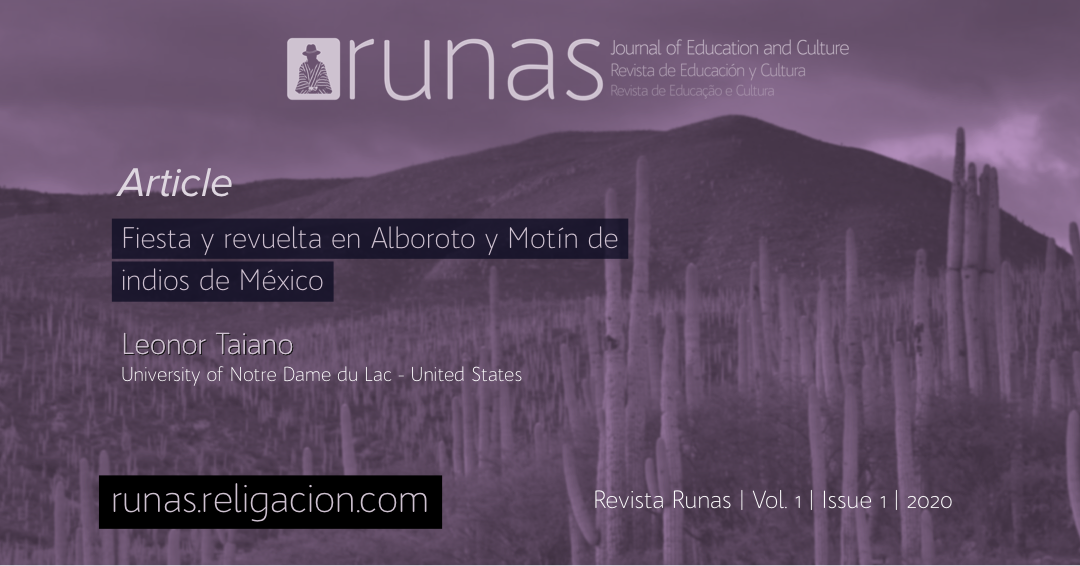Abstract
This research analyses how Carlos de Sigüenza and Góngora describes the dichotomy of festivity-revolt in Alboroto y motín de Indios de México. This study is structured in five parts. The first one takes as its starting point the concept of polis and the regulations for the common good. The second one alludes to the Spanish splendor produced in the different members of Novohispanic polis. The third part analyses the letrado’s function within the viceregal organization. The fourth part examines the active role of Female Indigenous in the revolt’s organization and development. Finally, in the fifth part, I propose the existence of a Plebeian collective consciousness within the viceroyalty of New Spain. Through this analysis, the study concludes that the revolt that took place In 1692 has all the characteristics of the revolts that happened in the Spanish territories throughout the 17th century, in which, during a celebratory event, there could arise insurrectionary actions to impose the isonomia in the polis.
References
Arana Pérez, F. J. (2005). Letrados, juristas y burócratas en la España Moderna. Universidad de Castilla La Mancha.
Argan, C. G. (1964). L’Europa delle capitali: 1600-1800. Fabbri Skira.
Bachini, A. (2011). Gli antichi Romani. Giunti Editore.
Barcia, R. (1869). Conversaciones con el pueblo español. Biblioteca revolucionaria.
Bercé, Y-M. (1994). Fête et révolte: des mentalités populaires du XVIe au XVIIIe siècle. Hachette.
Bornemann, M. M., & Aguirre Salvador, R. (2006). Los indios, el sacerdocio y la Universidad en Nueva España, siglos XVI-XVIII. UNAM.
Botero, G. (1997). Della ragion di Stato. Roma: Donzelli Editore.
Cave, T. (2007). How to read Montaigne?. Granta Books.
Cope, R. D. (1994). The limits of racial domination: Plebeian society in colonial Mexico City, 1660–1720. Madison: University of Wisconsin Press.
Cortés Tovar, R. (2000). Misoginia y literatura: la tradición greco-romana. En, M. T. López de la Vieja (coord.), Feminismo del pasado al presente (pp. 15-34.). Ediciones Universidad de Salamanca.
Costigan, L. H. (1997). Literatura, meio-ambiente e questões sócio-antropolôgicas: letrados barrocos e intelectuais pós-modernos. Revista Iberoamericana, 63 (181), 607-620. https://doi.org/10.5195/reviberoamer.1997.6175
Cruz Pazos, P. (2004). Cabildos y cacicazgos: alianza y confrontación en los pueblos indios novohispanos. Revista Española de Antropología Americana, (34), 49-162. https://revistas.ucm.es/index.php/REAA/article/view/REAA0404110149A
Hansen, J. A. (2008). Barroco, neobarroco e outras ruínas. Destiempos, 3(14), 169-215. http://www.destiempos.com/n14/dossierv.pdf
Jameson, F. (2002). The Political Unconcious: Narrative as a Socially Symbolic Art. Routledge.
Mandrou, R. (1959). Les soulèvements populaires et la société française du XVIIe siècle. Annales. 14(14), 756-765. https://doi.org/10.3406/ahess.1959.2879
Moraña, M. (2002). Sujetos sociales: poder y representación. En, R. Chang-Rodríguez (coord.), Historia de la literatura mexicana. La cultura letrada en la Nueva España del siglo XVII (pp. 47-68.) Siglo XXI Editores.
Pillorget, R. (1975). Les mouvements insurrectionnels de Provence entre 1595 et 1715. Presses Universitaires de France.
Raaflaub, K. A. (2005). Polis,‘the Political’, and Political Thought: New Departures in Ancient Greece, c 800–500 BCE. In, J. P. Arnason, S. N. Eisenstadt & B. Wittrock. Axial civilizations and world history (pp. 253-283). Brill
Rama, Á. (1984). La ciudad letrada. Ediciones del Norte.
Rodríguez Aguilera de Prat, C. (1983). La teoría del Estado en la España de los Austrias. Revista de estudios políticos, 36, 131-158. https://dialnet.unirioja.es/servlet/articulo?codigo=26760
Romero González, D. (2004). La Asamblea de mujeres de Aristófanes, ¿mezcla de realidad y ficción? Ámbitos: revista de Estudios de Ciencias Sociales y Humanidades, 11, 1-17 http://hdl.handle.net/10396/8726
Semo, E. (1985). Historia del capitalismo en México. Secretaría de Educación Pública.
Sigüenza y Góngora, C. (1984). Seis obras. Fundación Biblioteca Ayacucho.
Sologuren, J. (2004). “La ciudad inculpada” Obras completas de Javier Sologuren. Pontificia Universidad Católica del Perú
Thompson, E. P. (1971). The moral economy of the English crowd in the eighteenth century. Past & present, (50), 76-136. https://www.jstor.org/stable/650244?seq=1
Tilly, L. A. (1972). La révolte frumentaire, forme de conflit politique en France. Annales. Histoire, Sciences Sociales, 27(3), 731-757. https://doi.org/10.3406/ahess.1972.422534
Widiastuti. M. (2003). El enfoque de la ciudad: ni este, ni oeste: oposiciones que hay que superar en la historia de los enfoques de la ciudad (Reflexiones desde Bali). En, V. Berdoulay y H. Mendoza Vargas (Editores). Unidad y diversidad del pensamiento geográfico en el mundo. Retos y perspectivas (pp. 223-233). INEGI-UNAM.

This work is licensed under a Creative Commons Attribution-NonCommercial-NoDerivatives 4.0 International License.
Copyright (c) 2020 Leonor Taiano






